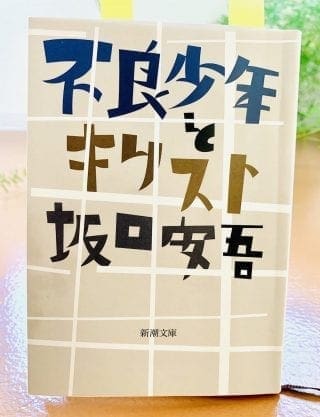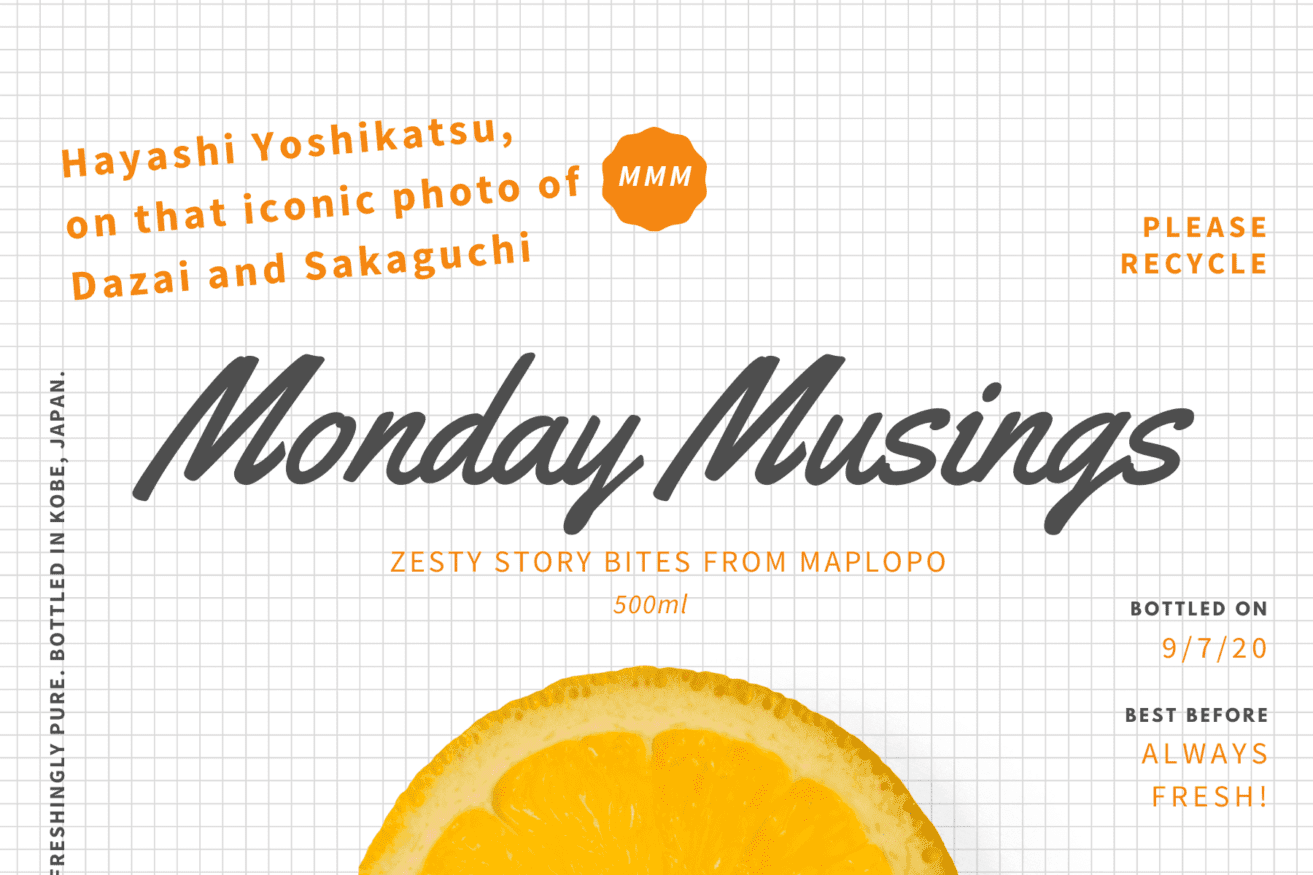Hayashi Yoshikatsu
“About the Frontispiece”
「口絵の写真について」林義勝
The frontispiece of Dazai Osamu taken by my father, Hayashi Tadahiko, is a familiar shot—people have been exposed to it frequently via photobooks and posters, and it is his most well known work. This picture is often cropped rectangularly in portrait mode, but the original is a square, medium format image. We introduced the non-cropped version, surprising all who saw it, during the first staging of the exhibit: *A True Showa Era Creation: The “Monster” of Photography, Hayashi Tadahiko, and His Storytelling of Showa Through Pictures which took place at Fujifilm Square’s Photo History Museum in 2018.
The person appearing next to Dazai on the right is Sakaguchi Ango. This is one frame from a shoot at Bar Lupin in Ginza taken in 1946, not long after the war. At the time, my father was riding on the **Kasutori magazine boom, working multiple assignments for over 20 publishers, while also shooting Buraiha Bungo writers who gathered at Bar Lupin—including its representative Bungo—Sakaguchi Ango, Oda Sakunosuke, and Dazai Osamu. Many of these photographs were later featured on the front gravure page of the Bunshi (literary men and women) series in Shyosetsu Shincho (‘Novels Shincho’) magazine spanning a period of two years that began in December, the following year.
This Dazai photo is one in a collection of such photos. Interestingly, my father didn’t seem to know Dazai was a writer according to his records. That day, he’d gone to Bar Lupin again to shoot Oda Sakunosuke and there was this drunken Dazai. He pestered my father, insisting, “Take my picture too!” Having no choice but to be obliged, my father shot Dazai using his last remaining flashbulb. That shot was this very photo, and it ended up being my father’s most celebrated work.
Want to read more in Japanese? Grab 『不良少年とキリスト』坂口安吾 in the Amazon.co.jp store.
口絵の太宰治の写真——父・林忠彦の代表作として知られ、写真集やポスターなどで頻繁に露出してきた、おなじみのカットです。しかしこの写真、いつも縦長の長方形にトリミングして使われてきましたが、オリジナルはブローニー判で撮影されていたのです。2018年(平成30)年フジフイルム スクエアの写真歴史博物館で開催された「昭和が生んだ写真・怪物 時代を語る林忠彦の仕事」展の第一部で、初めてノートリミングの状態で展示してみたのですが、ご覧になった方々は皆、驚いていました。
写真の右側に写っているのは坂口安吾さん。銀座のバー、ルパンでの一コマです。戦後間もない1946年(昭和21)年。当時、父はカストリ雑誌ブームに乗って、20誌以上も掛け持ちで仕事をしていましたが、一方で坂口安吾、織田作之助、太宰治はじめルパンにやってくる無頼派の文豪たちを撮影していました。その多くは翌年12月から始まった「小説新潮」の巻頭グラビア「文士」シリーズに、2年間にわたって掲載されました。
太宰の写真もその中の1枚。ただ、父の記録によれば、父は太宰を作家だと知らなかったそうです。この日も織田作之助の写真を撮るためにルパンに行ったのですが、そこに酔っ払った太宰がいて、「俺の写真も撮ってくれ」とせがまれたとのこと。仕方ないので最後にたったひとつ残っていたフラッシュバルブを使って撮った、まさに1枚だったのです。それが今や父の代表作となっています。
(写真家、「波」2018年9月号より抜粋)
坂口安吾(2019)『不良少年とキリスト』新潮文庫 pp. 244-245
* This is our translated title of the original title: 「昭和が生んだ写真・怪物 時代を語る林忠彦の仕事」
**The word Kasutori, used in this sense, refers to a type of short-lived magazine printed after the war. These magazines usually ended their publication run at or around their third issue. Financial difficulties, low readership, and the quality of the publication on the whole were the main reasons. As a result, these cultural gems took on the word for low-quality moonshine: Kasutori. Beside the easy-to-make manufacturing comparisons, Kasutori is known to have a particular potency—strong enough to render most drinkers quite intoxicated after only three drinks— and so, like the three issue limit the magazines seemed to share—the term stuck.

『不良少年とキリスト』 坂口安吾
Want to read more Monday Musings? Click here for the Monday Musings' menu.
Want to Read More Sakaguchi in English?
Check out the Maplopo translation of Ango Sakaguchi's ⾵と光と⼆⼗の私と Wind, Light, and the Twenty Year Old Me (Abridged). It's free to read, download, print, and share!
Want more Dazai in English?
Check out the Maplopo translation of Osamu Dazai's Wish Fullfilled (満願 ). It's free to read, download, print, and share!
